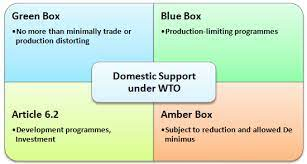Indian Economy
Boosting Oilseed Production
- 22 May 2021
- 5 min read
This article is based on “Making India Atmanirbhar in oilseeds” which was published in The Hindu Bussiness line on 21/05/2021. It talks about the challenges and policy measures to improvE the oilseed production in India.
Historically, member-countries of WTO questioned India on various agricultural issues including continued restrictions on pulses import, wheat stockpiling, short-term crop loans, export subsidies or minimum support price for various crops.
However, the latest attack is on India’s ambitious plan to step up domestic oilseeds output. According to the recent directives, the government envisages to reduce dependence on vegetable oil imports (palm, soybean and sunflower oils) which cost roughly $10 billion.
In order to prevent countries from dragging India in another WTO litigation, India should ensure the incentives are well within the permissible limits.
However, in the long term, India must find ways where it can boost domestic oilseeds output even without direct financial incentives or monetary support to growers.
Associated Challenges With Oilseed Imports
- Trade Policy: It is well known that more often than not, vegetable oil imports are excessive and speculatively driven.
- Due to this, importers build large inventory of low-priced imported oils within the country, which depresses domestic oilseeds prices and discourages oilseed growers.
- Credit Period & Import Debt-Trap: Overseas suppliers grant 90 to 150 days credit to Indian importers; but the cargo reaches Indian shores in about 10 days (palm oil) or 30 days (soft oils).
- The Indian importer sells the material immediately and enjoys liquidity for several months during which he indulges in rampant speculation and over-trading before he is required to remit payment.
- This is leading to a never-ending import cycle.
- Stagnant Production: Despite huge demand, oilseed production in India has got trapped at 31-32 million tonnes. We need to break this stagnation and aim to increase the output by at least two million tonnes a year, if not more.
Way Forward
- Increasing Green Box Subsidies: There is a need to increase public research spending in oilseed crops for development of biotic and abiotic stress tolerant varieties and other potential areas for yield breakthrough.
- Strengthening the oilseed crop seed chain, particularly in groundnut to match the variety specific demand for higher yield, will help immensely.
- Smart Agriculture: Ensuring availability of key physical (fertilizers, pesticides), financial (credit facilities, crop insurance) and technical inputs (extension services) in major crop ecological zones for oilseed crops.
- Marketing Reforms: Implement market reforms and policies, such as contract farming and publicprivate partnership in production and processing, to ensure a competitive market for oilseeds and edible oil along with adequate protective measures to avoid unfair competition from the international markets.
- Reducing Speculation: Reducing speculative and excessive imports of vegetable oil will immediately have a salutary effect on domestic oilseed prices.
- Further, to prevent dangerous debt-trap, the credit period for vegoil import should be restricted to maximum 30 days for palm oil and 45 days for soft oils.
- This will automatically discourage excessive imports, over-trading and speculation and encourage growers to plant more, improve agronomic practices and realise higher yields.
Conclusion
Improving local capacities and the social, economic and environmental sustainability of agriculture through delivery of technology and services and strengthening of institutions shall bring in the desired growth in the oilseed crop economy. This growth will be of immense benefit to the country as oilseeds are grown mainly in the disadvantaged regions.
|
Drishti Mains Question Through creative policy intervention, the government can help boost oilseeds production without any major financial outlay. Analyse. |





